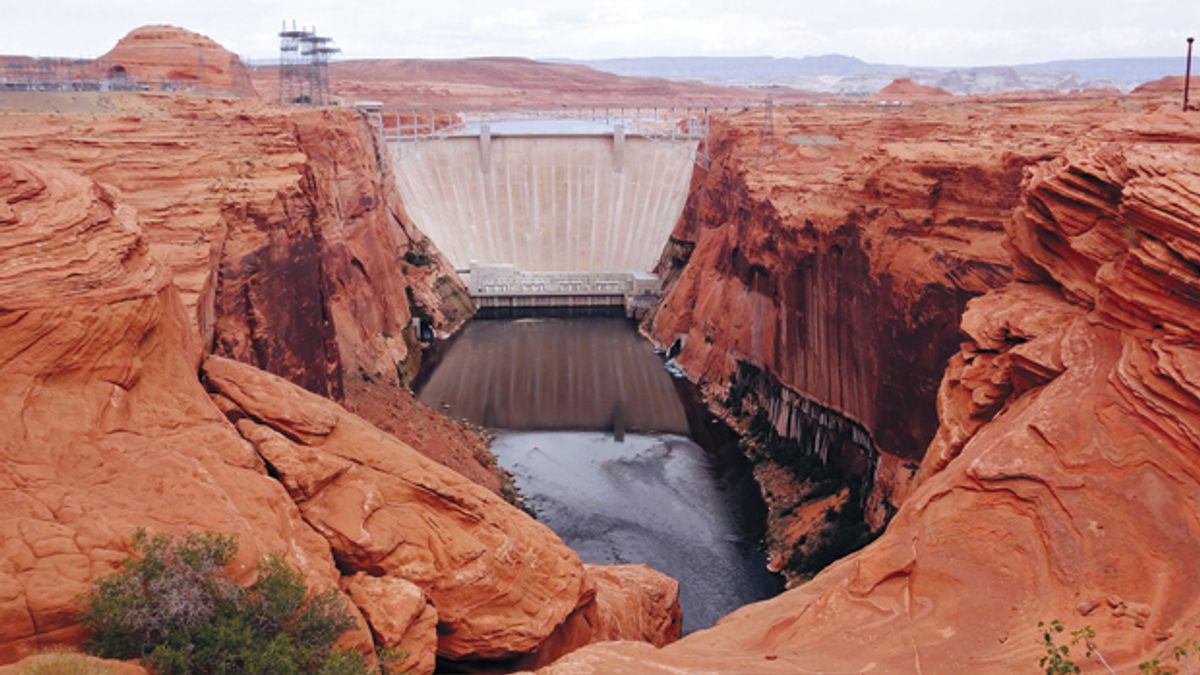Last year, the Hoover Dam hydroelectric plant installed the first of five wide-head turbines. These are designed to work efficiently even as the Colorado River shrinks under a record-long drought. The dry spell affecting the dam’s power source has outlasted any other in the 77 years that the structure has generated electricity. By the time the fifth turbine is installed in 2016, Hoover Dam will likely need them all.
Lake Mead, which sits on the border between Nevada and Arizona behind Hoover Dam, is expected to drop 2.4 meters in 2014, as less and less water flows downstream from Lake Powell, which straddles Utah and Arizona. The sharp decline comes about because the U.S. Bureau of Reclamation needs to cut Lake Powell’s water release by nearly 1 billion cubic meters to 9.2 billion m3 for the 2014 water season, the smallest release since the lake was filled in the 1960s. The flow of water to Lake Powell from key tributaries has been decreasing for more than a decade, and the bureau’s forecasters expect that the reservoir could hit an all-time low this season.
“This is the most extreme drought since measurements began in the early 1900s,” says Jack Schmidt, a professor of watershed sciences at Utah State University and current chief of the U.S. Geological Survey’s Grand Canyon Monitoring and Research Center. A heavy snowfall this winter could change everything, but “no one knows when this will end,” he adds.
The five new wide-head turbines being installed at the Hoover Dam are meant to keep the power plant working with less water in the lake. “We’re trying to increase the power we can get from decreasing levels of water,” says Rob Skordas, area manager of the Lower Colorado Dams office of the Bureau of Reclamation. Skordas says the new turbines should function well even if the water elevation falls to 305 meters above sea level, far below the historical average of 358.
Lake Mead, however, was already down to 337 meters in late August, when power capacity at Hoover Dam was at 1735 megawatts, down from a full capacity of 2074 MW. As water levels continue to decline, power output could fall even farther.
Upstream at the Glen Canyon Dam, power production is expected to be 8 percent lower than in 2013 as a result of the lower water, according to Jane Blair, manager of the bureau’s Upper Colorado power office. The bureau estimates that the Western Area Power Administration will have to spend about US $10 million to meet its electricity supply obligations.
If the situation doesn’t improve, Glen Canyon Dam could have even bigger problems. When the water level drops below 1063 meters, just about 30 meters below its August levels, vortex action would draw air into the turbines and damage them. Power generation would then likely cease at Glen Canyon, says Blair. Currently, engineers at Glen Canyon aren’t looking to install any wide-head turbines like those at Hoover Dam.
If the drought cycles become longer and more severe, hydropower and other power needs will continue to take a backseat to water supply for the southwest region of the United States and California. On the Colorado River, there is a total hydropower generating capacity of 4178 MW, but many of the plants are already operating below their measured capacities because of the drought. Nearly 30 million people depend on the river for drinking water and irrigation. “Producing hydropower is clearly essential to maintaining a secure energy system,” says Schmidt. “But in the grand scheme of things, water only comes from one place, and electricity comes from lots of places.”
If electricity has to come from somewhere else, delivering drinking water to some of the largest cities in the western United States could be particularly problematic. Nearly 30 percent of the energy from Hoover Dam goes to the Metropolitan Water District of Southern California, which provides drinking water to nearly 19 million people across 26 cities and water districts. Less power also means less money for various water quality and environmental studies that inform how the water from the Colorado River should be allocated.
Many experts would like this year to mark the end of the drought cycle, but all they can do now is hope for snow while planning for withering water resources. “I think it’s fair to say everybody involved with the river is hoping this coming winter is the snowiest winter on record,” says Schmidt.
A correction to this article was made on 20 September 2013.



